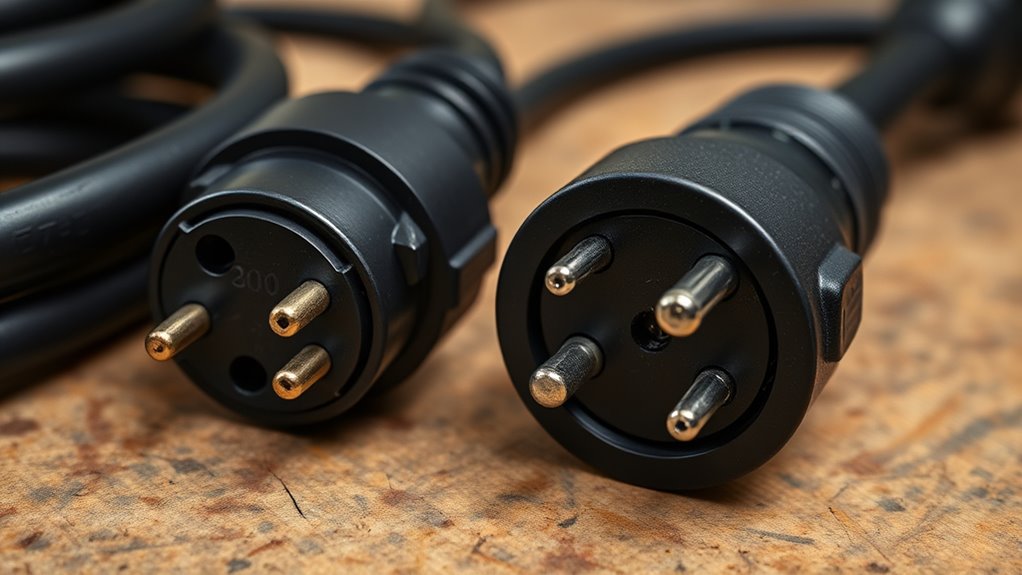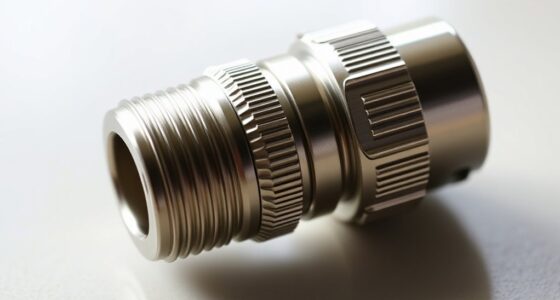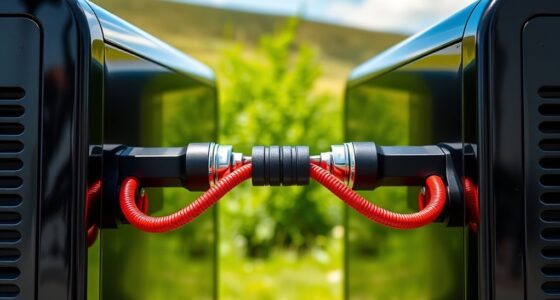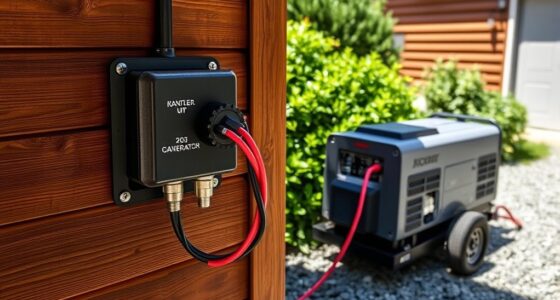Choosing between a 30-amp and a 50-amp generator cord depends on your power needs and equipment. If you run small appliances, RVs, or light tools, a 30-amp cord handles up to 7,200 watts safely. For larger RVs, heavy-duty tools, or high-power appliances, a 50-amp cord is better suited, supporting up to 12,000 watts. Ensuring compatibility and safety is essential—learn more to pick the right cord for your setup.
Key Takeaways
- Choose a 30-amp cord for small appliances and lightweight RV setups up to 7,200 watts.
- Opt for a 50-amp cord when powering large RVs, heavy-duty tools, or appliances exceeding 7,200 watts.
- Check your equipment’s amperage requirements before selecting the cord to prevent damage or safety hazards.
- Ensure connector compatibility: 30-amp cords have three prongs, 50-amp cords have four prongs.
- Consider future needs and safety features when choosing a cord to support higher power demands reliably.
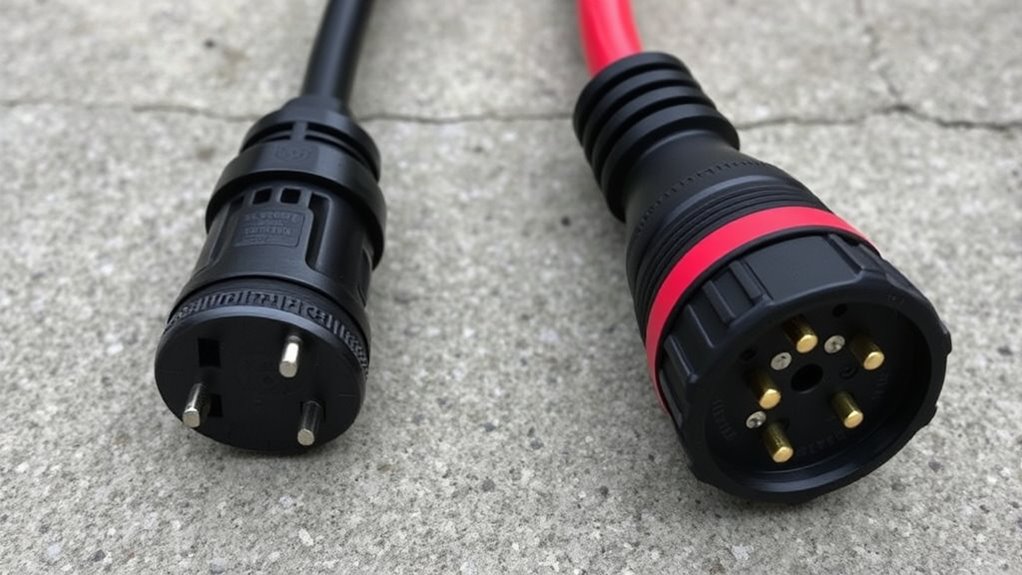
When choosing between 30-amp and 50-amp generator cords, understanding their differences is crucial to guarantee you get the right type for your power needs. The primary factor to consider is power capacity. A 30-amp cord typically handles up to 7,200 watts, making it suitable for smaller appliances, RVs, and light-duty equipment. In contrast, a 50-amp cord can support up to 12,000 watts, which is necessary for larger RVs, heavy-duty tools, and high-power appliances. Matching the cord’s capacity to your power demands prevents overloads and ensures safe operation.
Compatibility issues are another critical aspect. Not all appliances or RVs are designed to work with a specific amperage cord. If you connect a 30-amp cord to equipment that requires 50 amps, you risk underpowering your devices or causing potential damage. Conversely, using a 50-amp cord for a 30-amp setup can be unsafe and may lead to electrical failures. It’s essential to check the power specifications of your equipment before selecting a cord. Many RVs and generators have dedicated outlets labeled for their amperage, so verifying these labels helps avoid compatibility issues.
Furthermore, the physical design and connectors differ between the two types. A 30-amp plug usually features a three-prong design with a flat blade and a ground, while a 50-amp plug has a four-prong configuration to handle higher power loads and provide better grounding. Ensuring your cord matches your outlet prevents improper connections that could pose safety risks. Also, consider the length of the cord needed. Longer cords are more prone to voltage drops, especially with higher power loads, so select a length that balances convenience with safety.
Another point to keep in mind is future-proofing. If you plan to upgrade your RV or equipment later on, investing in a 50-amp cord might be more adaptable, provided your setup can handle the higher capacity. However, if your current setup only requires lightweight devices, a 30-amp cord will suffice and be more economical. Always prioritize safety and compatibility over cost or convenience.
Additionally, choosing a high-quality cable insulation can help prevent electrical hazards and extend the lifespan of your cords, especially when used outdoors or in harsh conditions.
Frequently Asked Questions
Can I Connect a 30-Amp Cord to a 50-Amp Outlet?
You shouldn’t connect a 30-amp cord to a 50-amp outlet because it can compromise extension compatibility and safety. The wiring and plug sizes differ, and forcing a connection risks electrical damage or fires. Always use a cord rated for the outlet’s amperage to guarantee proper extension compatibility and maintain cord safety. If unsure, consult a professional to prevent dangerous electrical issues.
Are 30-Amp and 50-Amp Cords Interchangeable?
No, 30-amp and 50-amp cords aren’t interchangeable because of electrical compatibility and cord versatility. Using a 30-amp cord on a 50-amp outlet can cause safety issues and damage your equipment. Always match the cord type to your outlet’s amperage to guarantee safe operation. Check your generator’s specifications carefully, and don’t force a cord that doesn’t fit—using the right one keeps everything running smoothly and safely.
What Appliances Require 50-Amp Power?
Power-hungry appliances like large RVs, electric stoves, and heavy-duty HVAC systems demand 50-amp power. With robust RV wiring and smart power management, these devices run reliably and efficiently. You need a 50-amp cord to handle hefty loads without hiccups, ensuring safe, steady supply. By understanding your appliances’ amperage needs, you keep your power flowing smoothly, preventing potential problems and promoting seamless, stress-free camping or working adventures.
How Do I Determine My Generator’s Amperage Needs?
To determine your generator’s amperage needs, check its power capacity, usually listed in watts. Divide the wattage by your voltage (typically 120V or 240V) to find the amperage. Make sure your appliances’ total amperage matches your generator’s electrical compatibility. Overloading can cause damage, so always select a generator with a higher capacity than your total needs for safe, efficient power.
Is a Higher Amp Cord Safer for My Generator?
A higher-amp cord isn’t inherently safer; it’s like giving a race car a bigger engine—it needs the right track. If the cord exceeds your generator’s grounding requirements or isn’t compatible, it can create dangerous electrical sparks. Always match the cord’s amperage with your generator’s needs and make certain of proper grounding. Using the correct, compatible cord keeps your setup safe and reliable, preventing overloads and electrical mishaps.
Conclusion
In the battle of 30-amp versus 50-amp, your choice depends on your needs. Consider your capacity, convenience, and the kind of power you require. Whether you opt for the smaller, simpler 30-amp or the robust, reliable 50-amp, make sure it matches your motor needs. Remember, making the right move guarantees your generator’s greatness, giving you peace of mind and plenty of power when you need it most. Pick wisely, and power up perfectly!
